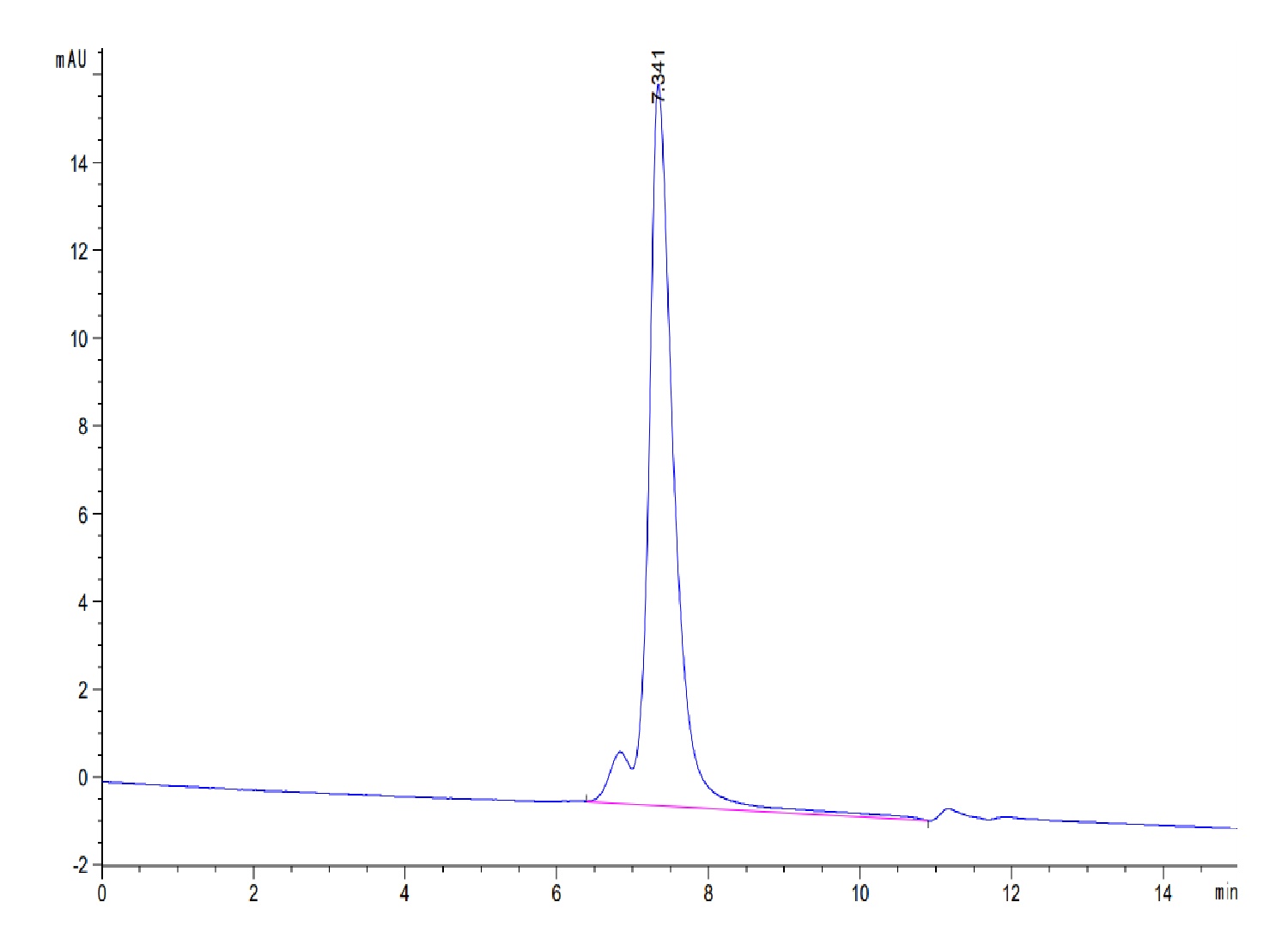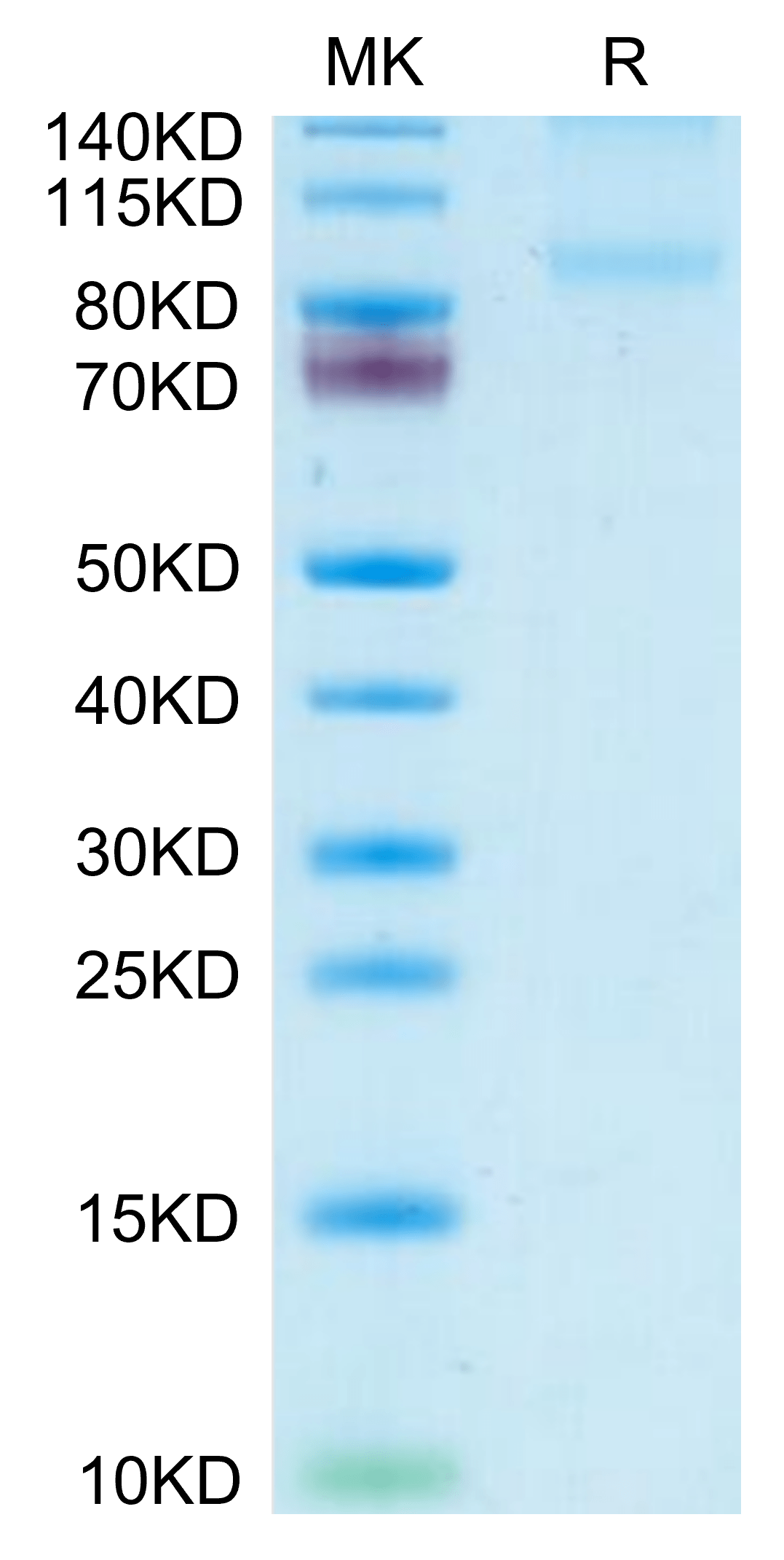| Weight | 1 lbs |
|---|---|
| Dimensions | 9 × 5 × 2 in |
| accession | Q08481 |
| express system | HEK293 |
| product tag | C-His |
| purity | > 95% as determined by Tris-Bis PAGE;> 95% as determined by HPLC |
| background | Platelet endothelial cell adhesion molecule 1 (PECAM-1) is an adhesion and signaling receptor that is expressed on endothelial and hematopoietic cells and plays important roles in angiogenesis, vascular permeability, and regulation of cellular responsiveness. |
| molecular weight | The protein has a predicted MW of 65.6 kDa. Due to glycosylation, the protein migrates to 90-100 kDa based on Tris-Bis PAGE result. |
| available size | 100 µg, 500 µg |
| endotoxin | Less than 1EU per μg by the LAL method. |
Mouse CD31/PECAM-1 Protein 3723
$300.00 – $1,000.00
Summary
- Expression: HEK293
- Pure: Yes (HPLC)
- Amino Acid Range: Glu18-Lys590
Mouse CD31/PECAM-1 Protein 3723
| protein |
|---|
| Size and concentration 100, 500µg and lyophilized |
| Form Lyophilized |
| Storage Instructions Valid for 12 months from date of receipt when stored at -80°C. Recommend to aliquot the protein into smaller quantities for optimal storage. Please minimize freeze-thaw cycles. |
| Storage buffer Shipped at ambient temperature. |
| Purity > 95% as determined by Tris-Bis PAGE |
| target relevance |
|---|
| Platelet endothelial cell adhesion molecule 1 (PECAM-1) is an adhesion and signaling receptor that is expressed on endothelial and hematopoietic cells and plays important roles in angiogenesis, vascular permeability, and regulation of cellular responsiveness. |
| Protein names Platelet endothelial cell adhesion molecule (PECAM-1) (CD antigen CD31) |
| Gene names Pecam1,Pecam1 Pecam Pecam-1 |
| Mass 81263Da |
| Function Cell adhesion molecule which is required for leukocyte transendothelial migration (TEM) under most inflammatory conditions (By similarity). Tyr-679 plays a critical role in TEM and is required for efficient trafficking of PECAM1 to and from the lateral border recycling compartment (LBRC) and is also essential for the LBRC membrane to be targeted around migrating leukocytes (By similarity). Trans-homophilic interaction may play a role in endothelial cell-cell adhesion via cell junctions (By similarity). Heterophilic interaction with CD177 plays a role in transendothelial migration of neutrophils (By similarity). Homophilic ligation of PECAM1 prevents macrophage-mediated phagocytosis of neighboring viable leukocytes by transmitting a detachment signal (By similarity). Promotes macrophage-mediated phagocytosis of apoptotic leukocytes by tethering them to the phagocytic cells; PECAM1-mediated detachment signal appears to be disabled in apoptotic leukocytes (By similarity). Modulates bradykinin receptor BDKRB2 activation (By similarity). Regulates bradykinin- and hyperosmotic shock-induced ERK1/2 activation in endothelial cells (By similarity). Induces susceptibility to atherosclerosis (PubMed:19048083). |
| Subellular location Cell membrane Membrane raft Cell junction Note=Localizes to the lateral border recycling compartment (LBRC) and recycles from the LBRC to the junction in resting endothelial cells. Cell surface expression on neutrophils is down-regulated upon fMLP or CXCL8/IL8-mediated stimulation. |
| Tissues Isoform 1 and isoform 3 are expressed in lung and platelets. |
| Structure Trans-homodimer (via Ig-like C2-type 1 and Ig-like C2-type 2 domains); trans-homodimerization is required for cell-cell interaction. Forms a complex with BDKRB2 and GNAQ. Interacts with BDKRB2 and GNAQ. Interacts with PTPN11; Tyr-702 is critical for PTPN11 recruitment. Interacts with FER. Interacts with CD177; the interaction is Ca(2+)-dependent; the interaction is direct. |
| Post-translational modification Phosphorylated on Ser and Tyr residues by src kinases after cellular activation (PubMed:16731527). Upon activation, phosphorylated on Ser-718 which probably initiates the dissociation of the membrane-interaction segment (residues 698-718) from the cell membrane allowing the sequential phosphorylation of Tyr-702 and Tyr-679 (By similarity). Constitutively phosphorylated on Ser-723 in resting platelets (By similarity). Phosphorylated on tyrosine residues by FER and FES in response to FCER1 activation (PubMed:16731527). In endothelial cells Fyn mediates mechanical-force (stretch or pull) induced tyrosine phosphorylation (By similarity). ; Palmitoylation by ZDHHC21 is necessary for cell surface expression in endothelial cells and enrichment in membrane rafts. |
| Target Relevance information above includes information from UniProt accession: Q08481 |
| The UniProt Consortium |
Data
 |
| The purity of Mouse CD31/PECAM-1 is greater than 95% as determined by SEC-HPLC. |
 |
| Mouse CD31/PECAM-1 on Tris-Bis PAGE under reduced condition. The purity is greater than 95%. |
Publications
Publications
| pmid | title | authors | citation |
|---|---|---|---|
| We haven't added any publications to our database yet. | |||
Protocols
| relevant to this product |
|---|
Documents
| # | ||
|---|---|---|
| Please enter your product and batch number here to retrieve product datasheet, SDS, and QC information. | ||














